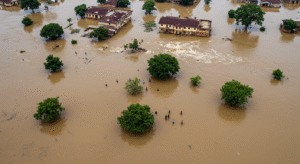 The 2025 Mokwa flood in Niger State, Nigeria, stands as one of the most devastating natural disasters in the region’s history. On May 28, torrential rains led to the overflow of the River Niger, submerging entire communities, destroying infrastructure, and displacing thousands. The flood claimed over 200 lives and left approximately 500 individuals missing, with more than 3,000 residents displaced. At least 500 households were affected, and critical infrastructure, including two bridges and several roads, was destroyed. The floodwaters also inundated vast agricultural lands, devastating local food supplies and livelihoods. The 2025 Mokwa flood in Niger State, Nigeria, stands as one of the most devastating natural disasters in the region’s history. On May 28, torrential rains led to the overflow of the River Niger, submerging entire communities, destroying infrastructure, and displacing thousands. The flood claimed over 200 lives and left approximately 500 individuals missing, with more than 3,000 residents displaced. At least 500 households were affected, and critical infrastructure, including two bridges and several roads, was destroyed. The floodwaters also inundated vast agricultural lands, devastating local food supplies and livelihoods.
Causes of the FloodThe Mokwa flood resulted from a combination of natural and human-induced factors: - Heavy Rainfall: Intense pre-dawn rains overwhelmed the River Niger, causing it to overflow its banks.
- Dam Management Issues: The collapse of a nearby dam exacerbated the situation, releasing excess water into the river system.
- Environmental Degradation: Deforestation, siltation of river channels, and encroachment on floodplains reduced the river’s capacity to contain heavy rainfall.
- Climate Change: Altered rainfall patterns and increased precipitation intensity contributed to the flood’s severity.
- Inadequate Infrastructure: Poor urban planning and lack of effective flood control measures left communities vulnerable.
Community Response and ResilienceIn the aftermath, the affected communities demonstrated remarkable resilience: - Collective Action: Residents collaborated to rescue survivors, share resources, and provide emotional support.
- Adaptive Strategies: Communities employed innovative solutions, such as using elevated platforms and makeshift boats, to navigate flooded areas and access essential services.
- Government and NGO Support: The Nigerian government, alongside humanitarian organizations, provided relief materials, medical assistance, and temporary shelters to the displaced populations.
Moving Forward: Building ResilienceThe Mokwa flood underscores the urgent need for comprehensive disaster risk management: - Infrastructure Development: Investing in flood control infrastructure, such as dams, levees, and drainage systems, is crucial.
- Environmental Conservation: Reforestation and sustainable land-use practices can help restore natural buffers against floods.
- Community Engagement: Empowering local communities with knowledge and resources enhances their capacity to respond to future disasters.
- Policy Implementation: Enforcing zoning laws and urban planning regulations can prevent construction in flood-prone areas.
By addressing these areas, Nigeria can strengthen its resilience against future floods and mitigate the impacts of climate change. Source: Nature News |

 The 2025 Mokwa flood in Niger State, Nigeria, stands as one of the most devastating natural disasters in the region’s history. On May 28, torrential rains led to the overflow of the River Niger, submerging entire communities, destroying infrastructure, and displacing thousands. The flood claimed over 200 lives and left approximately 500 individuals missing, with more than 3,000 residents displaced. At least 500 households were affected, and critical infrastructure, including two bridges and several roads, was destroyed. The floodwaters also inundated vast agricultural lands, devastating local food supplies and livelihoods.
The 2025 Mokwa flood in Niger State, Nigeria, stands as one of the most devastating natural disasters in the region’s history. On May 28, torrential rains led to the overflow of the River Niger, submerging entire communities, destroying infrastructure, and displacing thousands. The flood claimed over 200 lives and left approximately 500 individuals missing, with more than 3,000 residents displaced. At least 500 households were affected, and critical infrastructure, including two bridges and several roads, was destroyed. The floodwaters also inundated vast agricultural lands, devastating local food supplies and livelihoods. 